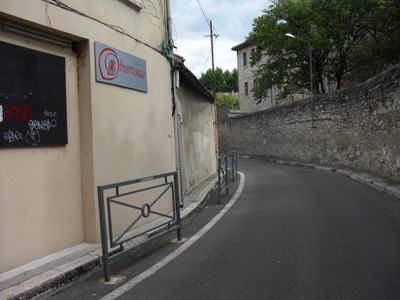
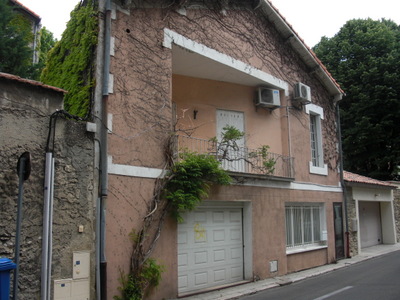 Tuesday morning, all the others decided they wanted to sleep in and not go anywhere until lunchtime. How can they do that? I mean, we were up late, but not that late . . .
Tuesday morning, all the others decided they wanted to sleep in and not go anywhere until lunchtime. How can they do that? I mean, we were up late, but not that late . . .Tuesday, 21 May 2013: Dancing on the Pont d'Avignon
Written Thursday, 6 June 2013

 Tuesday morning, all the others decided they wanted to sleep in and not go anywhere until lunchtime. How can they do that? I mean, we were up late, but not that late . . .
Tuesday morning, all the others decided they wanted to sleep in and not go anywhere until lunchtime. How can they do that? I mean, we were up late, but not that late . . .
Anyway, I had a leisurely breakfast and then set out on my own about 10 a.m., having agreed to meet them on the corner by the OT at noon. The route from the Porte Saint Roche into the city led me past these two wonderful examples of French domestic architecture. On the left, an interesting sort of concave wall; "Observance" is a theater, but I don't know what was behind the concavity. On the right, a clever way to incorporate a balcony without sticking it out over the street.

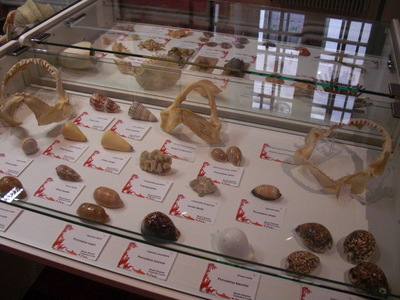 The city map we were given showed half a dozen different themed pedestrian tours. No audioguide or brochure was provided; the color-coded routes on the map just led the walker from historical marker to historical marker. I didn't have time to do a whole one, so I just followed whatever fragments of the various routes came my way.
The city map we were given showed half a dozen different themed pedestrian tours. No audioguide or brochure was provided; the color-coded routes on the map just led the walker from historical marker to historical marker. I didn't have time to do a whole one, so I just followed whatever fragments of the various routes came my way.
On the left, a small section of the 12th- and 13th-century city wall, well inside the restored 14th-century ramparts. A small plaque nearby commemorates historian and professor Franck Rolland, 1962–1998, who rediscovered and reconstituted the ancient walls of Avignon.
Following one of the recommended walking routes, I found myself outside the Natural History Museum, which wasn't one of the things we had planned to visit as a group. The card we got with our palace and bridge tour tickets, good for discounts at other museums, was alas back at the hotel, locked up with the still-snoozing David, but what the heck I went in anyway, and as it happens, admission was free.
What a beautiful little museum! Just inside the door was a screen continuously showing old black-and-white films of the last living thylacines, "marsupial tigers," which were declared extinct in 1936. Also in the extrance hall was a large case exhibiting some of their best specimens of stuffed animals.
Other cases displayed carefully labeled seashells, corals, and (of course) shark jaws.
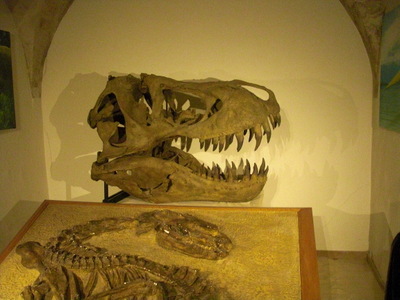
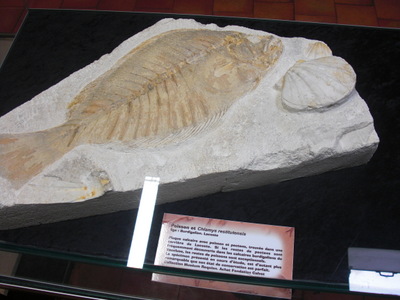 The place was too small for the kinds of diaramas and habitat reconstructions you see in larger museums, but they had the usual cases of stuffed animals and birds, thoughtfully arranged by continents and habitats and complemented by many explanatory panels.
The place was too small for the kinds of diaramas and habitat reconstructions you see in larger museums, but they had the usual cases of stuffed animals and birds, thoughtfully arranged by continents and habitats and complemented by many explanatory panels.
Paleotherium magnum, a Saint Bernard-sized mammal that was a "distant cousin of the horses, rhinoceroses, and tapirs." A sign below it warns visitors not to lean over too far to look at it, lest they trip the electric-eye alarm guarding it.
On the right a beautiful fish and scallop, fossilized in the same calcareous block.

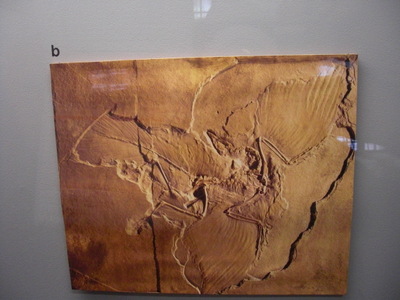 On the left here is the skull, perhaps two feet long, of Mosasaurus hoffmanni, pretty relentlessly carnivorous by the look of it.
On the left here is the skull, perhaps two feet long, of Mosasaurus hoffmanni, pretty relentlessly carnivorous by the look of it.
On the right is a slender creature with clearly defined fossil feathers on its limbs and tail. I've edited too many papers by Fran James to call it either a bird or a dinosaur. Somebody else can sort that out.
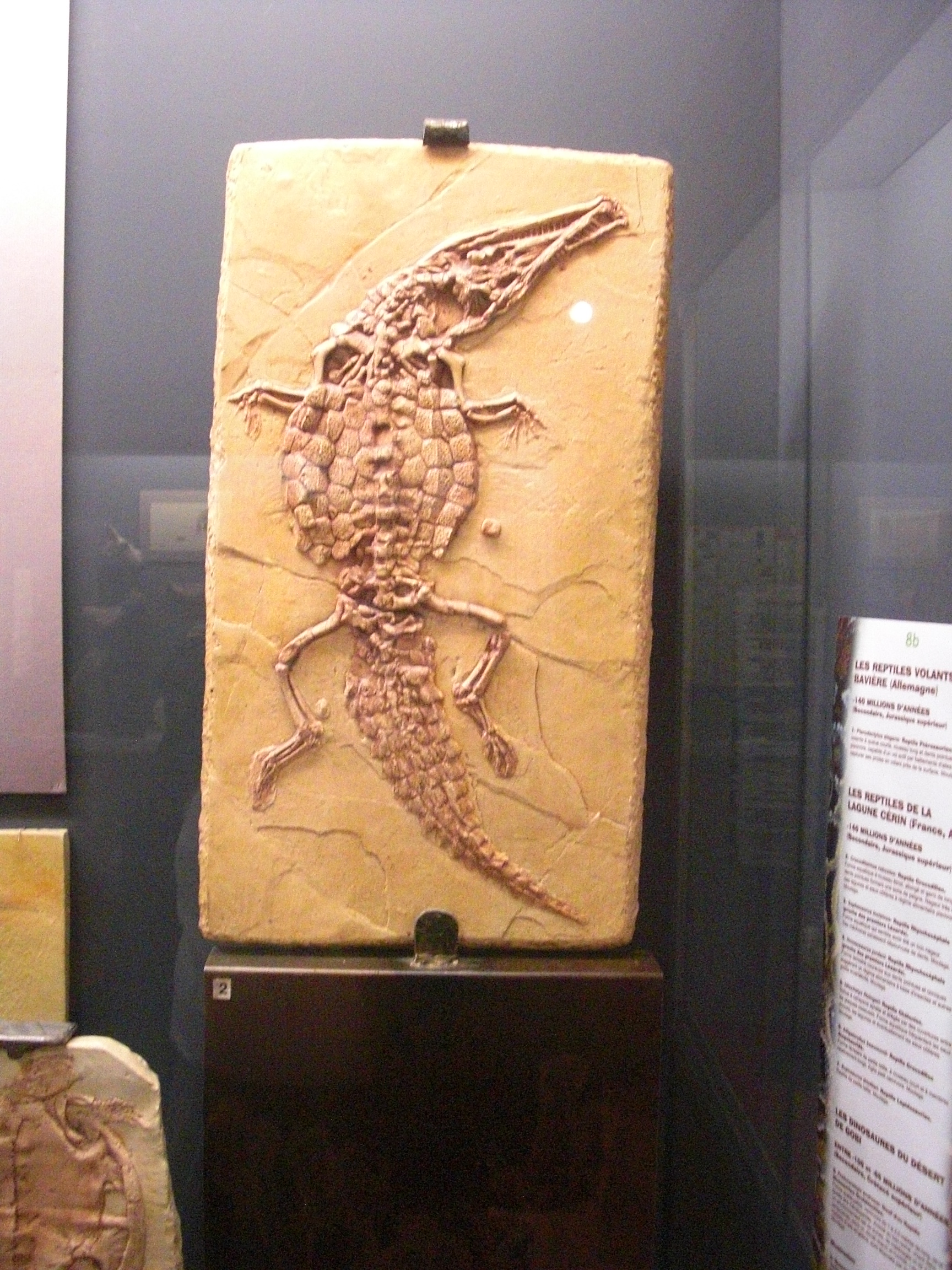
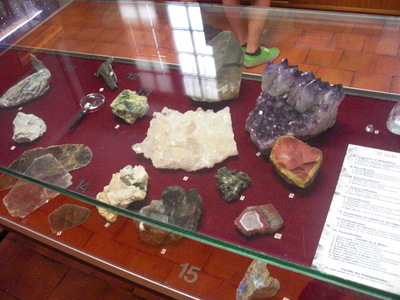 In a case nearby was the fossilized egg of Aepyornis an extinct ratite bird from Madagascar. It apparently stood 3 m tall, and its egg is at least four times the size of the ostrich egg displayed with it for scale.
In a case nearby was the fossilized egg of Aepyornis an extinct ratite bird from Madagascar. It apparently stood 3 m tall, and its egg is at least four times the size of the ostrich egg displayed with it for scale.
Another striking specimen was this crocodile-like fossilized reptile, perhaps a couple of feet long.
Toward the end of my circuit through the museum's few rooms, I came across cases full of beautiful crystals and other minerals.
I still wanted to scope out the locations of the two restaurants where he had Friday and Saturday reservations, so I didn't really give the museum the time it deserves. I definitely wouldn't mind getting back there sometime and actually reading all the panels and labels.

 I located one of the restaurants, Les 5 Sens, in an inner courtyard off a secondary street, then, on my way back to Place du Palais to locate the other one, I passed through this colorfully tiled courtyard (surrounded, I think, by appartment buildings). The pavement was actually flat and level; the ripple effect is an optical illusion generated by the zig-zag color pattern.
I located one of the restaurants, Les 5 Sens, in an inner courtyard off a secondary street, then, on my way back to Place du Palais to locate the other one, I passed through this colorfully tiled courtyard (surrounded, I think, by appartment buildings). The pavement was actually flat and level; the ripple effect is an optical illusion generated by the zig-zag color pattern.
Crossing the Place du Palais, I got this shot of a new sort of "busker" that we saw everywhere this year. The practitioner uses two rods joined by two slack lengths of cord, which he dips into the bucket of soapy water and then uses, in conjuction with any passing breeze, to blow huge, six-foot soap bubbles. The business plan seems to be that every child who sees the process wants to try it (as do a certain number of grownups), and the parents tip the practioner to let them.
In addition, I saw a couple of the typical statue-mimes and a guy dressed as Zorro. You tip to get the mimes to move and/or to take photos, with or without members of your part. The little white train passed within two feet of the Zorro, but when passengers (in motion and not in a position to tip) made to take his picture, he smilingly lowered his head (hiding his face behind his broad hat brim) and pulled in his arms, spoiling the photo. You had to come back later and tip if you wanted that picture.
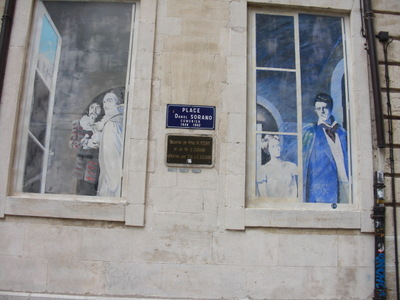
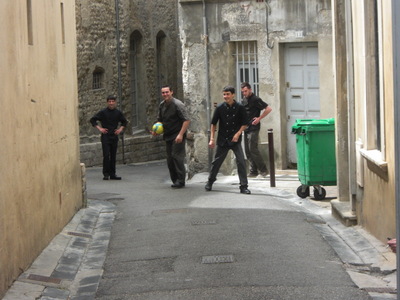 Avignon seems to have a particularly high density of theaters, and an artist, whether on his own or by arrangement with the city, has painted many, many windows (some in disused buildings, some unused, some artifical—added for symmetry—and even some in use) with scenes from the theatre. Some are of recognizable actors in recognizable roles, some labeled and some not. These are on Place Daniel Sorano (actor, 1920–1962) and are labeled "works by Mrs. M. Pochy and Mr. D. Durand, commissioned by Sté J. C. Decaux," so presumably they feature Sorano in real roles.
Avignon seems to have a particularly high density of theaters, and an artist, whether on his own or by arrangement with the city, has painted many, many windows (some in disused buildings, some unused, some artifical—added for symmetry—and even some in use) with scenes from the theatre. Some are of recognizable actors in recognizable roles, some labeled and some not. These are on Place Daniel Sorano (actor, 1920–1962) and are labeled "works by Mrs. M. Pochy and Mr. D. Durand, commissioned by Sté J. C. Decaux," so presumably they feature Sorano in real roles.
After locating the second restaurant, I started down a narrow little street behind it and encountered this group of young kitchen workers playing ricochet soccer in a wide spot. The street was surrounded by restaurants, so I don't know that they were from the kitchen of Christian Etienne, where we had reservations, but they could have been.
I also passed, or rather, was passed by, a pair of itinerant window cleaners on motorcycles. Each had a large box on the back of his bike, like the ones used for pizza delivery, presumably full of cleaning supplies, and bearing on both sides clips that held upright a collection of long-handled brushes, mops, and squeegees. In the U.S., of course, they would have been in a pick-up truck. (Pick-ups seem virtually unknown in France, their niche filled by small panel trucks.)
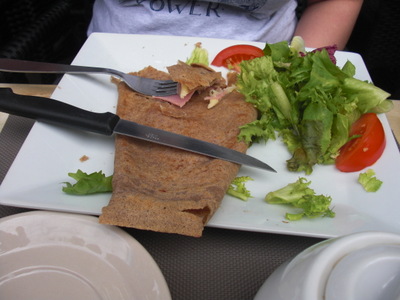
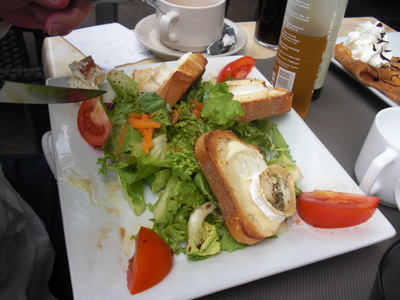 I got to the appointed street corner just at noon to find the others sitting on a doorstep waiting for me. We set off up the Rue de la République, reading menus, because CJ wanted a crêpe. We found what she was looking for at Au Petit Nice in the Place de l'Horloge. She ordered a ham and cheese crêpe.
I got to the appointed street corner just at noon to find the others sitting on a doorstep waiting for me. We set off up the Rue de la République, reading menus, because CJ wanted a crêpe. We found what she was looking for at Au Petit Nice in the Place de l'Horloge. She ordered a ham and cheese crêpe.
David, who can't digest the buckwheat most savory crèpes are made with in France, got his usual goat-cheese salad, again apparently made with Bûcheron.
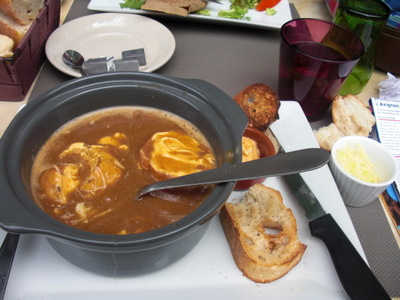
 I took the opportunity to order fish soup, which was served with the usual dish of grated cheese, croutons, and rouille (slightly spice red garlic mayo) to be added to taste; as you can see, I like lots). It was also, for once, served in an easy-to-eat-out-of open crock rather than the usual turnip-shaped tureen. Delicious.
I took the opportunity to order fish soup, which was served with the usual dish of grated cheese, croutons, and rouille (slightly spice red garlic mayo) to be added to taste; as you can see, I like lots). It was also, for once, served in an easy-to-eat-out-of open crock rather than the usual turnip-shaped tureen. Delicious.
Jeff, on the theory that life is short, had a chocolate-and-banana filled crêpe with vanilla ice cream and whipped cream drizzled with chocolate and caramel syrup. Go, Jeff!
On our way across the Place du Palais to use our tickets to the bridge, we found the little tourist train about to depart, with vacancies, so we did that first. Besides a circuit of the main streets and squares that we had already walked over, it took us up the hill behind the palace to the top of the "Rocher des Doms," a huge rock outcrop where the oldest settlement on the site was placed. It's a park now and provides panoramic views over the river and countryside. We saw statues of many favorite sons of the city as well as a magnificent war memorial that lists, in addition to those killed in the fighting, those who were deported to the concentration camps during WWII.
I'm told it includes a sundial which one reads by standing in a designated spot and reading the position of ones own shadow on the dial, but I didn't see it.
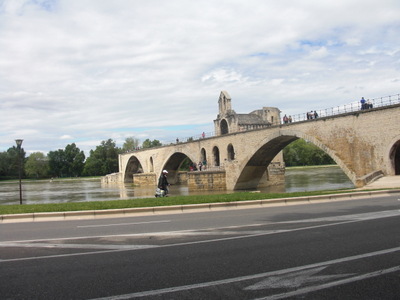
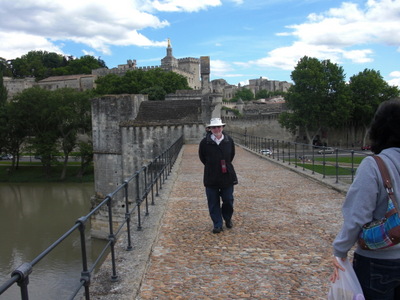 The Pont d'Avignon, the city's famous bridge to nowhere, gets more spectacular the more you know about it.
The audioguide is very information-rich, devoting about 2/3 of its entries to the bridge itself and the rest to the world-famous song (you could, for example, listen to renditions in every style from symphonic to nursery-rhyme to rock). You know, "Sur le pont d'Avignon, on y danse, on y danse . . ." David has always insisted that the words were "Sous le pont . . . ," and it turns out he's right in one sense. Historically, people did in fact dance under the bridge rather than on it, but for some reason, the words of the song are, in fact, "Sur le pont . . . ." I took care to dance a few steps on it—you just have to.
The Pont d'Avignon, the city's famous bridge to nowhere, gets more spectacular the more you know about it.
The audioguide is very information-rich, devoting about 2/3 of its entries to the bridge itself and the rest to the world-famous song (you could, for example, listen to renditions in every style from symphonic to nursery-rhyme to rock). You know, "Sur le pont d'Avignon, on y danse, on y danse . . ." David has always insisted that the words were "Sous le pont . . . ," and it turns out he's right in one sense. Historically, people did in fact dance under the bridge rather than on it, but for some reason, the words of the song are, in fact, "Sur le pont . . . ." I took care to dance a few steps on it—you just have to.
On the left is our view of the bridge from the street below, and on the right a view of David on the bridge itself. Behind him is the papal palace, and to the left of that the trees in the park of the Rocher des Doms. For once, he gave up and wore the dork strap.
The current bridge is four arches long, and at first glance, one wonders why they just didn't build on another couple and use the bridge, but from the audioguide we learned that what we see across the river is not, in fact, the far bank. It's the lower end of the largest island in the Rhône, large enough to have a town on it. When the bridge was built, it was 22 arches long (spanning the near channel, the low marshy island, which at the time was actually a group of smaller islands that have since merged, and the far channel) and wasn't straight; it incorporated not one but two bends. It also joined Provence (the independent kingdom in which Avignon was located) with France, on the far bank.
Its official name is the Pont Saint Bénénet, after the 12th-century shepherd who, obeying an order from God, came to Avignon to build it. He apparently began the process, and inspired others to join in, by miraculously single-handedly carrying the first stone, too large to any four men to lift, to the building site. It was apparently soundly enough constructed, but the Rhoône is notoriously changeable and, until times within living memory, produced terrible floods. At the time the bridge was built, the near channel was the principal course of the river and the other a backwater, but over the centuries, the island has repeatedly shifted in position, and silting and scouring have made the channels meander; now the principal channel is beyond the island. Floods and shifting footings caused first one arch and then another to collapse, and the bridge was used for hundreds of years with wooden "patches" spanning the broken bits. It was definitively abandoned in the 17th century, and now the four arches nearest the palace are the only ones still standing.
 The little stone building between the second and third arches is the two-story Chapel of Saint Bénézet, where the saint was originally buried. He was moved many times afterward, during wars, revolutions, etc., and his remains are now lost. On the left here is a view into the upper level of the chapel. Also included in the tour was the chance to walk a short section of the "chemin de ronde," the walkway along the top of the ramparts.
The little stone building between the second and third arches is the two-story Chapel of Saint Bénézet, where the saint was originally buried. He was moved many times afterward, during wars, revolutions, etc., and his remains are now lost. On the left here is a view into the upper level of the chapel. Also included in the tour was the chance to walk a short section of the "chemin de ronde," the walkway along the top of the ramparts.
On the right, the rest of the troops, laughing at me because I was actually trying to take a picture of the planter. David complains that I don't take enough photos of people, so the three of them took the opportunity to crowd into the shot. The Stanford hoodie is a gift from CJ's brother, who's in grad school there.
On the way back to the hotel, we stopped in to see the Musée Angladon, to see its few impressionists and other holdings. (In its lobby was a vending machine of a sort I hadn't seen before. You insert your SD card into it, select one or more of your own photos, insert 2 euros for 1 card (3 for 2, 5 for 5), and in just 15 sections, it spits out a picture postcard (or cards) of your photo! The wave of the future, I suspect.
The museum is based around the personal collection of Jacqus Doucet (1853–1929), a wealthy clothing merchant who met with great success in Paris. It includes works by Daumier, Degas, Sisley, Vuillard, Cézanne, Van Gogh, Picasso, and Modigliani, but the highlight of our visit was the temporary exhibition (no photos allowed) of antique photographs from the first quarter of the 20th century, called "Then and Now, in the City and on the Seashore." Some were familiar (CJ has a print of one of them on her wall at home), but others were new and all were fascinating.
Dinner was 20 km out of town, at La Maison Jaune in St. Remy de Provence. The GPS got us there just fine, but we're beginning to realize that the GPS's goal—to deliver us to the curb at the destination's front door— is not always the same as ours. Once we got close, we found a parking space and walked the last couple of blocks.

 We chose the Provençal tasting menu, so we all ate the same things. The initial amuse-bouche (with the glasses of champagne) was olives, but they were different from the usual black ones. They were fat and green and were marinated with lots of garlic (you can see bits of garlic all over ;and delicious.
We chose the Provençal tasting menu, so we all ate the same things. The initial amuse-bouche (with the glasses of champagne) was olives, but they were different from the usual black ones. They were fat and green and were marinated with lots of garlic (you can see bits of garlic all over ;and delicious.
Second amuse-bouche: Strips of luminous marinated salmon, sunny-side-up quail eggs, and cold cream of fennel. They brought two little trays like this, so we each got one of each kind.
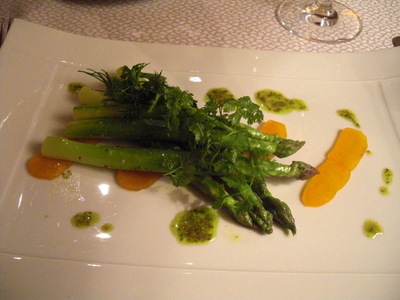
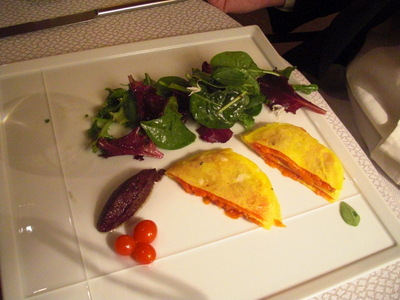 First course: Asparagus. It was listed on the menu as green asparagus with herb vinaigrette, but it arrived laid over the bright orange slices, which we first took to be cooked carrot, but the waiter who brought it, pointed it out as a bonus delicacy, describing it vaguely as "special fish." It was sort of waxy and gummy in texture and did taste of fish; I concluded it could only be fish roe. [The next morning, I woke up suddenly with a word in my head, one I would have said I didn't know: bottarga. What the heck is "bottarga?" I thought. Then it hit me—dried fish roe. I must have come across the concept somewhere in the past, and my subconscious dug it out and shoved it to the fore in the night. I looked it up on line, and sure enough, it's dried mullet roe, traditionally sliced crosswise, across the two parallel bundles of roe, yielding the two-lobed shape you can see in the photo. I'm actually quite fond of fresh mullet roe, simply sautéed, but I don't find the drying process an improvement.]
First course: Asparagus. It was listed on the menu as green asparagus with herb vinaigrette, but it arrived laid over the bright orange slices, which we first took to be cooked carrot, but the waiter who brought it, pointed it out as a bonus delicacy, describing it vaguely as "special fish." It was sort of waxy and gummy in texture and did taste of fish; I concluded it could only be fish roe. [The next morning, I woke up suddenly with a word in my head, one I would have said I didn't know: bottarga. What the heck is "bottarga?" I thought. Then it hit me—dried fish roe. I must have come across the concept somewhere in the past, and my subconscious dug it out and shoved it to the fore in the night. I looked it up on line, and sure enough, it's dried mullet roe, traditionally sliced crosswise, across the two parallel bundles of roe, yielding the two-lobed shape you can see in the photo. I'm actually quite fond of fresh mullet roe, simply sautéed, but I don't find the drying process an improvement.]
Second course: Thin, delicate, miniature flat omelets layered with a delicious stewed onion-and-tomato mixture, a small spring salad, a quenelle of olive tapenade, and three tiny, unbelievably flavorful and sweet heirloom cherry tomatoes. Wow! We add agreed this was an outstanding dish!

 Third course: Monkfish in "bourride" with seasonal vegetables. Bourride is a soup similar to bouillabaisse, but strongly flavored with garlic and often thickened with egg yolk. As you can see, very little soup was involved in this case, but all of it was delicious.
Third course: Monkfish in "bourride" with seasonal vegetables. Bourride is a soup similar to bouillabaisse, but strongly flavored with garlic and often thickened with egg yolk. As you can see, very little soup was involved in this case, but all of it was delicious.
Filet of lamb from the local "Alpilles" mountain range, grilled rare, and served with braised baby purple artichokes and a large, tender, slow-cooked clove of garlic. Tender and delicious.
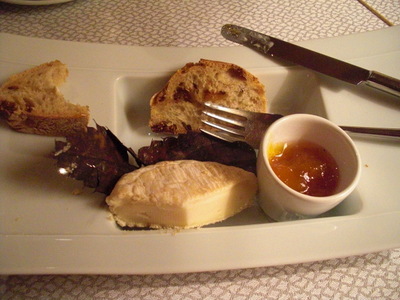
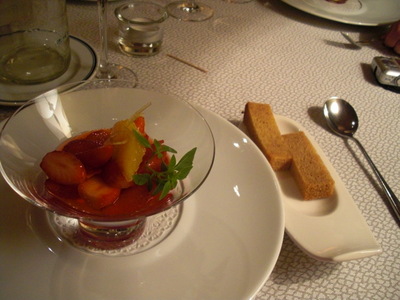 Cheese: Banon, a regional semisoft goat cheese, which they served wrapped in dried chestnut leaves, accompanied by house-made fruit marmelade and fruit-nut bread. We don't actually know whether CJK is allergic to chestnuts—no test is available—so I just warned her to take the leaf off right away, and she suffered no ill effects.
Cheese: Banon, a regional semisoft goat cheese, which they served wrapped in dried chestnut leaves, accompanied by house-made fruit marmelade and fruit-nut bread. We don't actually know whether CJK is allergic to chestnuts—no test is available—so I just warned her to take the leaf off right away, and she suffered no ill effects.
Dessert: Jelly of lemons from Menton (the town between Monaco and Italy where we attended the lemon festival in 2005), Gariguette strawberries, orange sections, and acacia honey. Very nice balance of sweet and acid. Yummy. [I wonder, though, whether the lemons had formed part of this year's festival's parade floats. The somewhat bruised fruit used on the floats is sold at a discount afterward, and lots of people buy it to make marmelade with. Did the chef put up a bunch of it as jelly to use in desserts?]
The GPS took us back by a very different route, way out around the city on an outer ring road, but finally got us back to places we recognized. I realized later that the whole circuitous path was the result of the GPS's determination to deliver us to the curb in front of the door. The hotel is on a divided road, so the GPS though it very important to bring us in facing the right direction, so that we would be on the right side of the road. We could much more simply have approached from the other direction (the one we left by) and taken a left turn at the hotel into our parking lot.